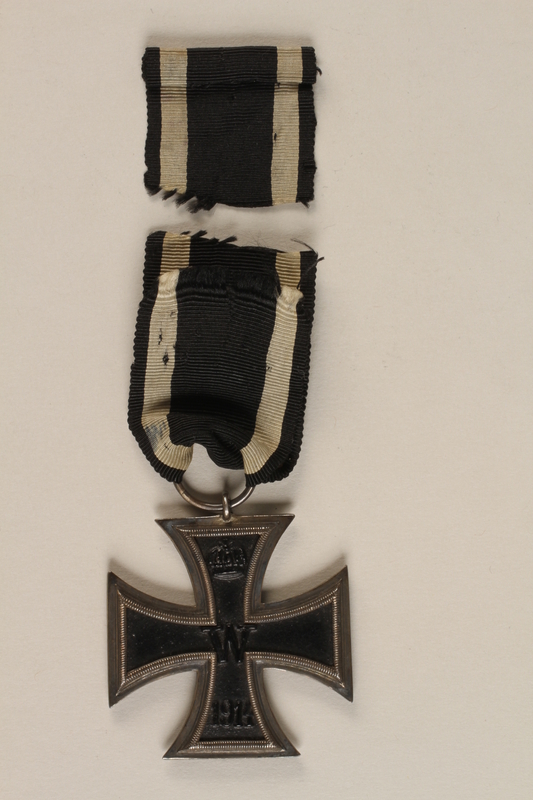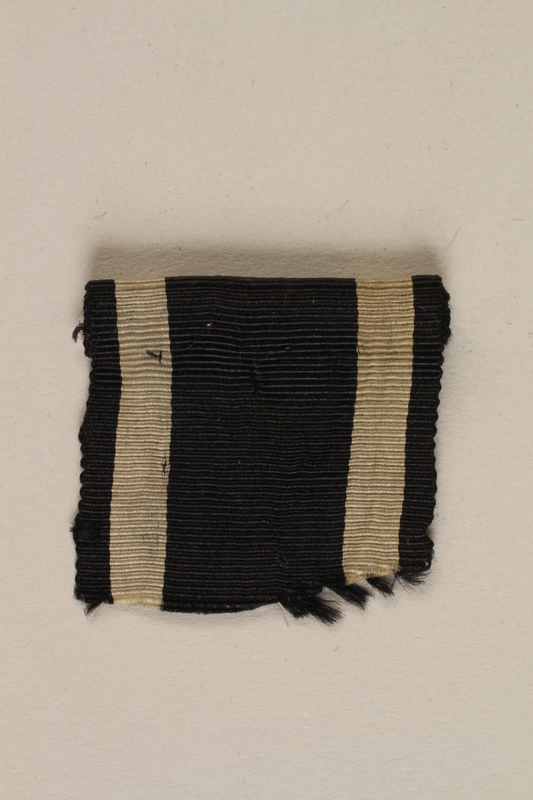Overview
- Brief Narrative
- Iron Cross, 2nd class medal awarded to Kurt Schlesinger for his service in the German Army during World War I (1914-1918). The Iron Cross was first issued in 1813 and was intended only to be issued in times of war. It was reinstated in August 1914, and awarded for bravery and distinguished deeds in combat during the Great War. On January 30, 1933, Adolf Hitler was elected Chancellor of Germany. Kurt and his second wife, Christine, were very concerned about Hitler’s policies, and immigrated to Amsterdam, Netherlands. Kurt left behind his teenage daughter, Irene, who lived in Berlin with her mother, Erna Schlesinger. Kurt and Erna had divorced in 1924, and he only saw Irene during holidays. In July 1938, Kurt signed a document granting permission for Irene, a minor, to emigrate because the situation for Jews in Germany had become more dangerous. In July 1939, Irene and Erna arrived in Amsterdam to say goodbye to him before boarding a ship to the United States. Germany invaded the Netherlands on May 10, 1940. In the second half of 1942, Kurt was transported to Westerbork transit camp and held there. After approximately one year, Christine, who was not Jewish, was able to get Kurt out the camp before he could be deported to a concentration camp. In February 1946, Kurt was killed instantly when he was thrown from the bed of a truck during an accident.
- Date
-
commemoration:
1914-1948
issue: after 1914 August 05
- Geography
-
issue:
Germany
- Credit Line
- United States Holocaust Memorial Museum Collection, Gift of Irene S. Woods
- Markings
- a. front, center, medal, embossed : (crown) / W / 1914
a. back, center, medal, embossed : FW / (oak leaves) / 1813 - Contributor
-
Subject:
Kurt J. Schlesinger
Subject: Irene S. Woods Hofstein
- Biography
-
Kurt Joseph Schlesinger (1885-1946) was born in Berlin, Germany, to Max (1853-1898) and Harriet Holz (1862-1929) Schlesinger. The couple married on October 19, 1884, and lived in Berlin. Kurt had an older brother, Fritz (1886 -?), and a younger sister Hanna (1891-?). Kurt worked as an apprentice lumberman in the early 1900s, and eventually became a lumber broker. He would buy and sell lumber by the wagonload and ship it by rail from Poland and Russia. He fought as an officer for Germany during World War 1 (1914-1918) and earned two medals, an Iron Cross, 2nd class, and an Honor Cross. On May 19, 1918, Kurt married Erna Meier (1897-1991) and they settled in the Zehlendorf borough of Berlin. Erna was the daughter of Hermann (1868-1904) and Jenny Gruenberg (1874-1944) Meier, and the step-daughter of Adolf Pelz (1865-1935). Kurt’s sister, Hanna, married Max Pelz in 1918, and they had one daughter, Susanne (1921-?). Kurt and Erna had one daughter, Irene (later Woods Hofstein, 1921-2016). In 1924, Kurt and Erna divorced. Erna moved in to her parents’ home and took Irene with her. Kurt only saw Irene on Sundays and during school vacations. Kurt’s brother, Fritz, married Margarete Wilde on October 19, 1924, and they had one son, Klaus (ca 1925 -?). In 1929, Kurt married Christine (Christal) Dahlhausen (1900-?), a non-Jewish woman, and the couple moved to Cologne. Kurt saw Irene only when she visited during the summer.
On January 30, 1933, Adolf Hitler was elected Chancellor of Germany, and there was a large parade to celebrate. Kurt was very concerned by this election and Hitler’s policies. As a result, Kurt and Christine immigrated to Amsterdam, Netherlands. He continued to be a lumber broker, and occasionally worked in other countries when necessary. His daughter Irene’s maternal Aunt Ruth and her family were also concerned, and immigrated to Palestine. In 1934, Irene had to be removed from public school because she was being harassed for being Jewish. She was sent to a private Jewish school in Hilversum, near Amsterdam. In April 1935, Irene returned to Berlin to say goodbye to her dying grandfather, and stayed there to attend the Waldschule Kalski, a private school for Jewish children.
In September 1935, the German authorities passed the Nuremberg Laws, which excluded people of Jewish ancestry from German citizenship, stripped them of their political rights, and forbid mixed marriages with non-Jews. Kurt sent packages with basic supplies to his ex-wife, Erna, who could not get certain thing as a Jewish woman in Berlin. In 1936, Irene left the Kalski School to attend a convent school in Belgium because of the low tuition rate. In 1937, Irene’s maternal Aunt Ruth and her family immigrated to the United States. Irene finished school and returned to Berlin. On July 14, 1938, while Irene was visiting him at a summer work site in Romania, Kurt signed a document granting permission for her to emigrate. In fall 1938, Irene, her mother, and her grandmother applied for US visas.
In late July 1939, Irene and her mother, Erna, arrived in Amsterdam to say goodbye to Kurt and other relatives before boarding a ship to the US. Irene’s grandmother, Jenny, was not on their visa and stayed behind in Berlin. Kurt and Irene had a fight, but he still accompanied Irene and Erna to their ship, the S.S. Statendam on July 25, his birthday. Unfortunately, he and Irene parted on poor terms. After she arrived in the US, he did not write her much, and following the German invasion of the Netherlands in May 1940, it was hard to get non-business mail out of the country. Following the invasion, Kurt and his relatives in the Netherlands were unable to leave the occupied nation. Kurt was able to send a message through in July to congratulate Irene on her engagement. On August 25, 1940, Irene, Kurt’s daughter, married Egon Klappholz (later Woods, 1912-1968) in Boston, Massachusetts. Kurt’s second wife Christine was a Christian, and was able to return to Cologne, though he could not go with her. Kurt wrote to Irene’s grandmother, Jenny Pelz, several times, and when possible he would send her food packages containing hard to find items like coffee, tea, chocolate, cheese, oatmeal, and sausage.
On November 5, 1941, Kurt sent a postcard to his brother Fritz in Berlin. The card was later returned, marked “moved -- address unknown.” He finally tracked down Fritz, and in May and June of 1942, Kurt sent him packages in Litzmannstadt (Łódź), where he was being held. Later, Kurt was transported to Westerbork transit camp in preparation for deportation to a concentration camp. In the fall of 1942, while being held, Kurt received a postcard from Jenny Pelz. Kurt was unable to respond until October of 1943, after his wife Christine managed to get him released before being deported. By the time he wrote to Jenny, she had been imprisoned at Theresienstadt ghetto-labor camp in German-occupied Czechoslovakia for more than half a year. In March 1943, Kurt’s first granddaughter had been born in the US. After the war ended in 1945, Irene wrote regularly imploring Kurt and Christine to join her family in New York, but he did not want to start his life over in a new place with a new language. In February 1946, Kurt was catching a ride in the back of a truck, when the tailgate gave way and he was thrown from the moving vehicle. He was killed instantly. Christine sent a telegram to his daughter, Irene, to inform her. The last letter Kurt sent to Irene was dated just 11 days before his death. On May 16, 1944, Jenny Pelz, Kurt’s ex-mother-in-law, had been deported to Auschwitz killing center in German-occupied Poland. Kurt’s brother, Fritz, and nephew, Klaus, were likely deported to Auschwitz and killed. Fritz’s wife Margarete survived in London, England, where she later died. Kurt’s sister, Hanna, brother-in-law, Max, and niece, Susanne, were likely deported to Auschwitz and killed.
Irene Schlesinger (later Woods Hofstein, 1921-2016) was born in Berlin, Germany, to Kurt Joseph (1885-1946) and Erna Meier Pelz (1897-1991) Schlesinger. Kurt was a lumber broker and the son of Max (1853-1898) and Harriet Holz (1862-1929) Schlesinger. Erna Meier (1897-1991) was born in Berlin, to Hermann (1868-1904) and Jenny Gruenberg (1874-1944) Meier. In 1906, Jenny married Adolf Pelz (1865-1935), a lumber broker with an office on the Unter den Linden Boulevard. In 1924, Erna and Kurt divorced. Erna took Irene with her and moved into her parents’ home near the zoo. The family lived comfortably and employed several staff members. Irene regularly attended synagogue with her grandparents, and they were culturally Jewish, celebrating the high holidays and lighting Shabbat candles. Kurt only saw Irene on Sundays and during vacation. In 1925, Irene’s aunt, Ruth, married doctor Arnold Hirsch Esrati (1901-1959), and they had one son, Stephen Hirsch (b. 1927). In 1929, Kurt married Christine (Christal) Dahlhausen (1900-?), a Christian woman, and the couple moved to Cologne. Irene attended local public schools in Berlin.
On January 30, 1933, Adolf Hitler was elected Chancellor of Germany. Irene’s father Kurt and her Aunt Ruth and Uncle Arnold, were concerned about Adolf Hitler’s policies and decided to emigrate. Kurt and Christine immigrated to Amsterdam, Netherlands. Ruth, Arnold, and their son Stephan immigrated to Palestine. In 1934, Irene had to be removed from public school because she was being harassed for being Jewish. She was sent to a private Jewish school in Hilversum, near Amsterdam. In April 1935, Irene was called back home so that her dying grandfather, Adolf, could say goodbye. Irene stayed in Berlin and attended Waldschule Kalski, a private Jewish school. In September, the German authorities passed the Nuremberg Laws, which stripped Jewish people of their rights and banned them from many public venues.
In 1936, Irene left the Kalski School to attend a convent school in Belgium because of the low tuition rate. Irene finished school and returned to Berlin. In 1937, Aunt Ruth’s family left Palestine for the United States, and settled in Boston, Massachusetts. On July 14, 1938, while Irene was visiting her father at a work site in Romania, he granted permission in writing, for her to emigrate. In the fall of 1938, Irene and her mother applied for visas to immigrate to the US, with Ruth and Arnold sponsoring their affidavits. US authorities did not believe that Ruth and Arnold could support both Erna and Irene, so they required additional support. Ruth called all of the Schlesingers in the Boston phone book and asked if they would be willing to provide an affidavit. Harvard University professor Arthur Schlesinger agreed to help them. In October, an inspector came to Irene’s house, reviewed all of their packed possessions, and wrote out a Reichsfluchtsteuer or a tax bill for fleeing the Reich. Before Erna and Irene were permitted to leave, they had to pay the German state the monetary equivalent to their personal property. In early November, during the Kristallnacht pogrom, Irene watched her synagogue burn as Germans cheered.
Irene received a visa in July 1939, and her Uncle Arnold, who was visiting Berlin, convinced the American consulate to include her mother as well. The consulate would not agree to add Irene’s grandmother, Jenny. In mid-July, Irene and Erna said goodbye to Jenny at the train station and then boarded a train to Amsterdam. Irene and Erna said goodbye to Irene’s father, Kurt, and other relatives in Amsterdam. On July 25, Kurt accompanied Irene and Erna to the S.S. Statendam. Mother and daughter arrived in the US in August.
On September 1, 1939, Germany invaded Poland, pushing France and Great Britain to declare war on Germany. Irene got a job at a wholesale greeting card company, and Erna cleaned houses and watched children. Irene attended meetings of the Immigrants Mutual Aid Society, where she met Egon Klappholz (1912-1968, later Woods), a young German Jewish immigrant who worked as a porter in a men’s clothing store in Boston. Egon was born in Königshütte, Germany (now Chorzów, Poland). The Klappholz family owned a department store in Germany, and he worked as a buyer of fabrics and dry goods. On November 10, 1938, Egon was arrested during Kristallnacht and spent 5 weeks in Buchenwald concentration camp. He immigrated to the US in March 1939.
In May 1940, Germany invaded the Netherlands, and Irene’s father and relatives were trapped in an occupied nation. On August 25, Irene, married Egon in Massachusetts. Irene’s grandmother, Jenny, was forced to move several times in Berlin, often living with other Jewish people in divided apartments. The family tried very hard to get Jenny a visa, and even paid someone to get her to Cuba. Unfortunately, that person stole their money and the US consulate told Jenny that she needed additional papers and more money. Eventually, she took jobs as a cook and housekeeper, and later at a factory to attempt to stay in Berlin. Irene received her last letter from Jenny on December 3, 1941. It is likely that Irene could not get more letters from Jenny because mail from Germany was stopped due to America’s entry into World War II, following the December 7 Japanese bombing of Pearl Harbor in Hawaii. On March 18, 1943, Jenny was deported to Theresienstadt ghetto-labor camp in German-occupied Czechoslovakia, on transport I/90. She was able to send messages from the camp, but not to her family in the US because she had the wrong forms. On May 16, 1944, Jenny was deported to Auschwitz killing center in German-occupied Poland, on transport Ea, and likely killed upon arrival.
Egon became a manager of a men’s clothing store in Brighton. Both Irene and Egon became US citizens, and Americanized their surname to Woods. They had two daughters. In February 1946, Kurt was killed in a traffic accident. Egon died in October 1968. Irene became a medical secretary and managed an orthopedic medical practice for 30 years. Irene regularly participated in alumni events for students of the Kalski School, and after one of these events, she reunited with a former boyfriend, Guy Hofstein (previously Ernst Günther, 1920-2011). In August 1938, he left Germany for England and later spent much of the war in France living with relatives under an assumed name, and eventually joining the French army. On December 1, 1994, Irene married Guy Hofstein in Massachusetts.
Physical Details
- Classification
-
Military Insignia
- Category
-
Medals
- Object Type
-
Medals, German (lcsh)
- Genre/Form
- Military decorations.
- Physical Description
- a. Black painted, iron alloy, cross pattée medal with flared ends and a silver plated outer border with a reeded inner line border. The front and back have an embossed design arranged in a central column. The front design has a crown at the top, the Royal Cipher at the center, and the year the medal was reinstated at the bottom. The back design has a crown above the Royal Cipher at the top, followed by a sprig of 3 oak leaves with 2 acorns in the center, and the year the medal was first issued at the bottom. A suspension ring with a large bail is attached to the center of the upper arm. Threaded through the bail is a grosgrain ribbon with five vertical stripes: a wide black center flanked by white stripes and narrow black edges. The ends of the ribbon are irregularly cut and fraying where the top end (b) has been removed. There are small black stitches along one side of the ribbon, where the two sides are tacked together. There are several small holes in worn areas of the ribbon, the white stripes are discolored, and the silver border is tarnished throughout.
b. Unevenly cut, top half of the grosgrain ribbon for an iron cross medal (a) with five vertical stripes: a wide black center flanked by white stripes and narrow black edges. The top of the ribbon is folded several times forming a roll of material that has been sewn to the ribbon with a loose basting stitch with black thread. The bottom ends of the ribbon are unevenly cut where the ribbon was removed. The ends are frayed and worn, with several worn sections and a small pinhole in the body. - Dimensions
- a: Height: 3.750 inches (9.525 cm) | Width: 1.625 inches (4.128 cm) | Depth: 0.125 inches (0.318 cm)
b: Height: 1.125 inches (2.858 cm) | Width: 1.125 inches (2.858 cm) - Materials
- a : iron alloy, silver, ribbon, thread, paint
b : ribbon, thread
Rights & Restrictions
- Conditions on Access
- No restrictions on access
- Conditions on Use
- No restrictions on use
Keywords & Subjects
- Topical Term
- Holocaust, Jewish (1939-1945)--Germany. Jewish refugees--Netherlands--Biography. Jewish refugees--United States--Biography. World War (1914-1918)--Participation, Jewish. Soldiers--Germany. Jews--Persecution--Germany.
- Geographic Name
- Berlin (Germany) Amsterdam (Netherlands)
- Corporate Name
- Westerbork (Concentration camp)
Administrative Notes
- Legal Status
- Permanent Collection
- Provenance
- The medal was donated to the United States Holocaust Memorial Museum in 1988 by Irene S. Woods, the daughter of Kurt Schlesinger.
- Record last modified:
- 2022-07-28 18:21:02
- This page:
- https://collections.ushmm.org/search/catalog/irn372
Download & Licensing
In-Person Research
- By Appointment
- Request 21 Days in Advance of Visit
- Plan a Research Visit
- Request to See This Object
Contact Us
Also in Kurt Schlesinger family collection
The collection consists of Honor and Iron Cross medals, buttonhole ribbon bars, correspondence, and documents relating to the experiences of Kurt Schlesinger and his family in Germany, the Netherlands, and the United States before and during the Holocaust.
Date: 1885-1944
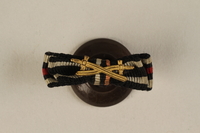
World War I Honor & Iron Crosses buttonhole ribbon bar with Combatant’s swords awarded to a German Jewish soldier
Object
Buttonhole ribbon bar for the Honor Cross, combatants and Iron Cross, 2nd class medals awarded to Kurt Schlesinger for his service in the German Army during World War I (1914-1918). The Honor, or Hindenburg, Cross was established by President von Hindenburg in July 1934. It commemorated distinguished deeds in combat, and individuals had to apply to the government to receive it. The Iron Cross was reinstated in August 1914, and awarded for bravery. On January 30, 1933, Adolf Hitler was elected Chancellor of Germany. Kurt and his second wife, Christine, were very concerned about Hitler’s policies, and immigrated to Amsterdam, Netherlands. Kurt left behind his teenage daughter, Irene, who lived in Berlin with her mother, Erna Schlesinger. Kurt and Erna had divorced in 1924, and he only saw Irene during holidays. In July 1938, Kurt signed a document granting permission for Irene, a minor, to emigrate because the situation for Jews in Germany had become more dangerous. In July 1939, Irene and Erna arrived in Amsterdam to say goodbye to him before boarding a ship to the United States. Germany invaded the Netherlands on May 10, 1940. In the second half of 1942, Kurt was transported to Westerbork transit camp and held there. After approximately one year, Christine, who was not Jewish, was able to get Kurt out the camp before he could be deported to a concentration camp. In February 1946, Kurt was killed instantly when he was thrown from the bed of a truck during an accident.
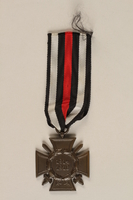
Honor Cross of the World War 1914/1918 combatant veteran service medal awarded to a German Jewish soldier
Object
Honor Cross, combatants medal awarded to Kurt Schlesinger for his service in the German Army during World War I (1914-1918). The Honor, or Hindenburg, Cross was established by President von Hindenburg in July 1934. It commemorated distinguished deeds in combat, and individuals had to apply to the government to receive it. On January 30, 1933, Adolf Hitler was elected Chancellor of Germany. Kurt and his second wife, Christine, were very concerned about Hitler’s policies, and immigrated to Amsterdam, Netherlands. Kurt left behind his teenage daughter, Irene, who lived in Berlin with her mother, Erna Schlesinger. Kurt and Erna had divorced in 1924, and he only saw Irene during holidays. In July 1938, Kurt signed a document granting permission for Irene, a minor, to emigrate because the situation for Jews in Germany had become more dangerous. In July 1939, Irene and Erna arrived in Amsterdam to say goodbye to him before boarding a ship to the United States. Germany invaded the Netherlands on May 10, 1940. In the second half of 1942, Kurt was transported to Westerbork transit camp and held there. After approximately one year, Christine, who was not Jewish, was able to get Kurt out the camp before he could be deported to a concentration camp. In February 1946, Kurt was killed instantly when he was thrown from the bed of a truck during an accident.
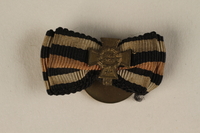
Honor Cross of the World War 1914/1918 non-combatant veteran service buttonhole ribbon bar awarded to a German Jewish soldier
Object
Buttonhole ribbon bar for the Honor Cross, non-combatants medal awarded to Kurt Schlesinger for his service in the German Army during World War I (1914-1918). The Honor, or Hindenburg, Cross was established by President von Hindenburg in July 1934. The medal was designed by Eugene Godet, and the ribbon bears a miniature version of the full scale award. It commemorated distinguished deeds in combat, and individuals had to apply to the government to receive it. On January 30, 1933, Adolf Hitler was elected Chancellor of Germany. Kurt and his second wife, Christine, were very concerned about Hitler’s policies, and immigrated to Amsterdam, Netherlands. Kurt left behind his teenage daughter, Irene, who lived in Berlin with her mother, Erna Schlesinger. Kurt and Erna had divorced in 1924, and he only saw Irene during holidays. In July 1938, Kurt signed a document granting permission for Irene, a minor, to emigrate because the situation for Jews in Germany had become more dangerous. In July 1939, Irene and Erna arrived in Amsterdam to say goodbye to him before boarding a ship to the United States. Germany invaded the Netherlands on May 10, 1940. In the second half of 1942, Kurt was transported to Westerbork transit camp and held there. After approximately one year, Christine, who was not Jewish, was able to get Kurt out the camp before he could be deported to a concentration camp. In February 1946, Kurt was killed instantly when he was thrown from the bed of a truck during an accident.
Irene Schlesinger passport
Document
German passport ["Deutsches Reich Reisepass"] issued to Irene Schlesinger (donor), July 1939, Berlin, Germany. Issued by Chief of Police, Berlin; letter "J" stamped in red ink; middle name "Sara" added; contains immigration visa for the United States dated July 13, 1939; contains stamp issued in the Netherlands dated July 19, 1939.
Egon Klappholz Woods passport
Document
German passport ["Deutsches Reich Reisepass"] issued to Egon Klappholz Woods (donor's late husband), August 1935, Berlin, Germany. Issued by Lord Mayor, Berlin in 1935; letter "J" stamped in red ink; contains immigration visa for the United States, dated February 17, 1939; contains a stamp dated March 16, 1939 at Harwich in the United Kingdom, alongside a visa for transit through the UK to the United States issued in Berlin on February 20, 1939.


